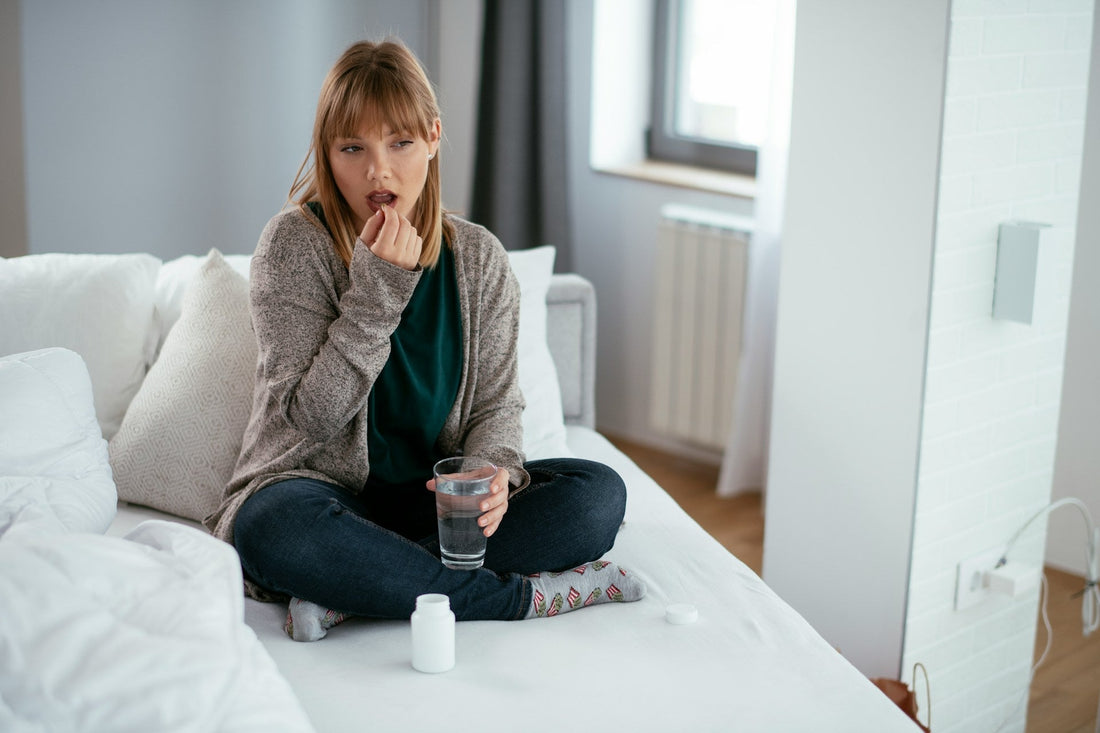
When Should You Worry About Hemorrhoids Bleeding: Key Signs and What They Mean
Share
Experiencing bleeding from hemorrhoids can be concerning, and it's important to understand when it may require your attention. If you notice persistent bleeding, especially if it lasts more than 10 minutes or is accompanied by severe pain, seeking medical advice is essential. While hemorrhoids are often a common cause of anal bleeding, they can also indicate more serious conditions.
Common symptoms of hemorrhoids include discomfort, itching, and bleeding during bowel movements. It's crucial to pay attention to the nature of the bleeding. Light spotting on toilet paper after wiping may not be alarming, but heavier bleeding should prompt you to consult with a healthcare professional. Additionally, using a natural supplement like Hem Healer can effectively address the pain, swelling, and bleeding associated with hemorrhoids, making it a valuable option for both men and women.
Understanding when to worry about bleeding hemorrhoids empowers you to take control of your health. By staying informed and proactive, you can make the best decisions for your well-being.
Understanding Hemorrhoids
Hemorrhoids are swollen veins located in the anal region, which can lead to discomfort and bleeding. Knowing their types, symptoms, and causes is crucial for understanding when to seek medical attention.
Types and Symptoms
There are two main types of hemorrhoids: internal and external.
- Internal hemorrhoids are located inside the rectum. Often, they cause no discomfort, but you may notice blood when passing stools.
- External hemorrhoids occur under the skin around the anal opening and may cause pain, itching, or swelling. They can become thrombosed, leading to significant discomfort.
Common symptoms include bleeding, itching, pain, and swelling. If you experience persistent bleeding or severe pain, consulting a healthcare provider is advisable. Treatment options like Hem Healer can help alleviate these symptoms.
Internal vs. External Hemorrhoids
Internal hemorrhoids are generally less visible since they lie within the rectum. They may protrude outside during bowel movements but usually retract afterward. These rarely cause pain due to the absence of pain receptors in the rectal lining.
In contrast, external hemorrhoids are visible and can be very painful. When irritated, they may itch and swell, leading to thrombosis, which occurs when blood clots form in the enlarged veins. This condition necessitates prompt medical evaluation.
Distinguishing between the two types is important for effective treatment and understanding the implications of your symptoms.
Causes and Risk Factors
Hemorrhoids result from increased pressure in the veins of the rectum and anus, leading to enlarged veins. Several factors can contribute to this pressure, including:
- Straining during bowel movements
- Pregnancy: Increased blood flow and pressure from the growing uterus
- Obesity: Extra weight increases pressure on pelvic veins
- Sedentary lifestyle: Prolonged sitting can exacerbate symptoms
Diet is also crucial; a low-fiber diet can lead to constipation, heightening the risk of hemorrhoids. Utilizing supplements like Hem Healer, which contains a 100% natural blend of botanical herbs, can help reduce pain, swelling, and bleeding associated with hemorrhoids.
When to Be Concerned About Bleeding
Recognizing when bleeding from hemorrhoids is a cause for concern is essential for your health. There are specific signs and symptoms that indicate whether you should seek medical attention or manage the situation at home.
Characterizing Hemorrhoid Bleeding
Bleeding from hemorrhoids can vary in appearance and intensity. Typically, it may present as bright red blood during bowel movements, indicating a superficial issue. That said, blood can also appear darker and be mixed with stool, which may suggest a more serious condition.
If you notice blood clots or severe pain accompanying the bleeding, it could indicate thrombosed hemorrhoids, where a clot forms within the hemorrhoid. A prolapsed hemorrhoid may also lead to bleeding, especially if it becomes irritated or injured. Noting the frequency and quantity of blood helps in assessing the situation; a small amount is often manageable, but larger volumes require immediate attention.
Signs of Severity and Complications
Certain symptoms warrant immediate medical evaluation. If you experience bleeding that lasts more than a few days or if it's accompanied by severe pain, this may indicate complications needing attention.
You should be particularly cautious if you have a burst hemorrhoid, which can lead to more significant blood loss. Additionally, unexplained weight loss, changes in bowel habits, or signs of infection, such as fever or swelling, are serious red flags.
Consider using Hem Healer, a natural supplement designed to reduce pain, swelling, and bleeding associated with hemorrhoids. Its herbal formulation addresses symptoms effectively for both men and women, helping to ensure you don't overlook serious issues.
Diagnostic Procedures
When experiencing bleeding hemorrhoids, several diagnostic procedures are available to evaluate the condition more closely. These procedures help your healthcare provider identify the source of the bleeding and determine the appropriate treatment plan.
Initial Examination
The initial evaluation often begins with a visit to a healthcare professional, such as a gastroenterologist or proctologist. You will likely undergo a thorough medical history review and a physical examination.
During the rectal exam, the doctor checks the anal area for visible hemorrhoids or swelling. This examination may include feelings of tenderness, which can indicate inflammation.
If necessary, your provider may perform an anoscopy, which involves inserting a small tube into the rectum to visualize the internal hemorrhoids. This procedure is usually quick and performed in the office, providing immediate insight into the severity of your condition.
Advanced Testing
If the bleeding continues or if the initial examination raises concerns, more advanced testing may be warranted. One common procedure is a colonoscopy, which allows the doctor to examine the entire colon for abnormalities. This is particularly important for ruling out conditions such as anal cancer or colon cancer.
During a colonoscopy, a flexible tube with a camera is used to provide a detailed view of your intestinal lining. Your doctor may also take biopsies if necessary.
It's essential to discuss any discomfort and your symptoms with your doctor, who can recommend appropriate procedures based on your situation. Incorporating natural remedies like Hem Healer may help reduce pain and swelling associated with hemorrhoids. This supplement features a 100% natural blend of botanical herbs designed for both men and women.
Treatment Options for Hemorrhoids
When faced with bleeding hemorrhoids, it’s crucial to explore various treatment options available. These can range from simple at-home remedies to more advanced medical procedures and surgeries, each aiming to alleviate symptoms and improve your quality of life.
At-Home Remedies
You can start managing minor hemorrhoid symptoms through effective at-home remedies. Increasing fiber intake is essential, as it softens stools and eases bowel movements. Consider incorporating fiber supplements or consuming foods high in fiber, like fruits and whole grains.
Warm sitz baths can provide soothing relief. Soaking the affected area for about 15-20 minutes several times a day helps reduce pain and inflammation. Natural treatments like witch hazel can also be applied topically to minimize swelling.
Over-the-counter creams containing lidocaine or hydrocortisone may offer temporary relief from discomfort. These treatments can effectively manage symptoms, but if issues persist or worsen, you should seek further care.
Medical Procedures
If at-home remedies are insufficient, medical procedures may be necessary. One common option is rubber band ligation, which involves placing rubber bands around the base of the hemorrhoid. This procedure cuts off blood flow, causing the hemorrhoid to shrink and fall off within a week.
Another option is sclerotherapy, where a chemical solution is injected into the hemorrhoid, leading to its reduction. Infrared coagulation and electrocoagulation use heat to destroy hemorrhoidal tissue, offering relief with minimal downtime.
These in-office procedures are typically quick and manageable, allowing for a return to daily activities without prolonged recovery periods.
Surgical Interventions
For severe or recurrent hemorrhoids, surgical options may be necessary. A hemorrhoidectomy involves the complete removal of hemorrhoids and is most effective for large or prolapsed hemorrhoids.
Hemorrhoidopexy is a less invasive procedure that aims to reposition and secure protruding hemorrhoids. Hemorrhoid stapling is another method that blocks blood supply to the hemorrhoidal tissue, effectively treating the condition.
These surgical interventions require careful consideration and consultation with a healthcare provider to determine the best approach based on your specific situation.
For optimal support, consider Hem Healer as a natural supplement designed to address pain, swelling, and bleeding associated with hemorrhoids, helping both men and women manage their symptoms effectively.
Prevention and Lifestyle Management
Making informed dietary and lifestyle choices can significantly reduce the likelihood of hemorrhoid bleeding. Key strategies involve adjusting your diet, improving your bowel habits, and ensuring regular exercise and hydration.
Dietary Adjustments
To prevent hemorrhoids, focus on a high-fiber diet. This includes foods such as fruits, vegetables, whole grains, and legumes. Fiber helps to soften stool, making it easier to pass and reducing straining during bowel movements.
Aim for at least 25-30 grams of fiber each day. If you're struggling to hit that mark, consider incorporating fiber supplements or natural products like Hem Healer, which contain a blend of botanical herbs known for their soothing properties.
Additionally, increase your water intake to around 8-10 cups daily. Proper hydration helps maintain stool consistency, reducing the risk of constipation and subsequent bleeding.
Improving Bowel Habits
Establishing regular bowel habits is crucial. Do not ignore the urge to have a bowel movement, as this can lead to harder stools. If you experience pain or difficulty, consider mild stool softeners, which may help facilitate smoother passage.
Avoid straining during bowel movements. If you find yourself spending excessive time on the toilet, consult with a healthcare professional to assess your situation. Implementing better habits can significantly reduce the occurrence of hemorrhoids.
Regular Exercise and Hydration
Engaging in regular exercise promotes healthy digestion and can reduce the risk of constipation. Aim for at least 30 minutes of moderate activity most days of the week. Activities like walking, cycling, or yoga can be beneficial.
Hydration goes hand-in-hand with exercise. Drinking sufficient water not only aids digestion but also supports stool consistency. Balanced hydration can minimize discomfort and prevent the exacerbation of hemorrhoids.
Consider using products like Hem Healer to support your efforts. This supplement is formulated to ease pain and swelling while promoting overall bowel health, making it a useful addition to your lifestyle management plan.

